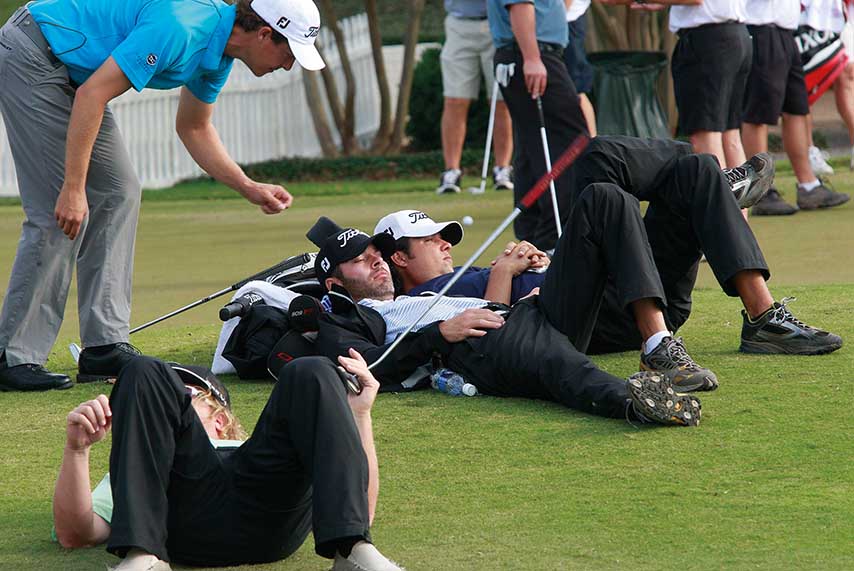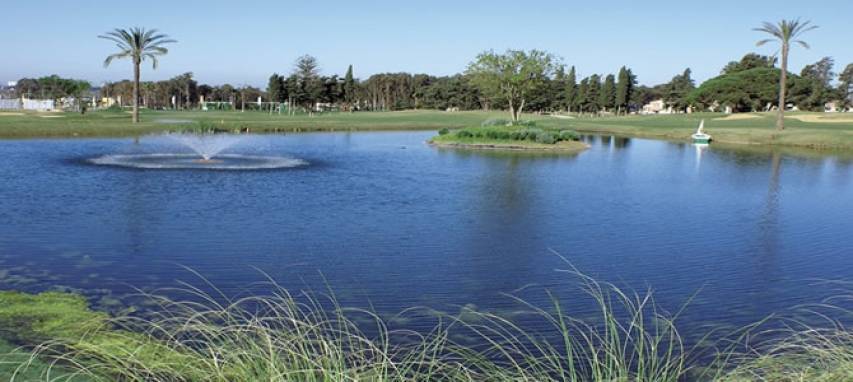In the past golf’s governing authorities have tended to be identified with an obdurate resistance to change and an intractable defence of the game’s sometimes inexplicable rules. Many people, for example, still recall – with a combination of derision and bemusement – the “No dogs, no women” sign with which one notable British club once welcomed visitors to its parking area.
Other antediluvian golf clubs have since also amended their gender-discriminatory rules, even if anachronistic practices still prevail at some. And in recent years there have been further reassuring signs that even golf’s most fierce guardians of tradition are aware of the burgeoning clamour for change and are willing to countenance it, if only to avert what has become a troubling decline in the number of golfers around the world. Self-interest has a way of focusing the mind.
Last year, for example, the Royal & Ancient (which oversees the Rules of Golf with the United States Golf Association) introduced “Ready Golf” to improve the pace of play. And, in a commendably prompt response to another thorny issue, the R&A and USGA agreed to adopt a new set of protocols for video review when applying the Rules. This followed such high-profile incidents as Lexi Thompson’s four-stroke penalty in an LPGA Tour major last year that essentially cost her the title (she eventually lost in a play-off).
Tour officials around the world have also displayed a welcome sense of creativity when it comes to tournament formats, as highlighted by the World Super 6 Perth in Western Australia, which returns in February after its inaugural event in 2017; the Shot Clock Masters, making its debut on this year’s European Tour in Austria in June; a European Tour-sanctioned mixed event (men and women) in Glasgow in August; and concerts by top rock bands at the BMW PGA Championship at Wentworth.
Closer to home in 2017, the Andalucía Costa del Sol Match Play 9 at La Cala Resort (Mijas municipality) comprised two days of stroke play, after which the top 32 players advanced to nine-hole match play rounds over the weekend. (The 2018 European Challenge Tour schedule was still to be confirmed at the time of going to press.)
These are in addition to an end-of-year period that is customarily taken up with a series of non-official, novel-format, limited-field invitational, exhibition and other golfing events – many featuring the world’s top-ranked players, albeit in more relaxed and informal mode than during the more pressurised official stages of the season.
For example, in Florida last December… the PNC Father/Son Challenge in Florida, where Jack Nicklaus played with his grandson Gary “GT” Nicklaus for the first time, and where Bernhard Langer alternates his partner between daughter Christina and son Jason; and the QBE Shootout, where the two-person teams included Tony Finau and Lexi Thompson (the latter becoming the first female to compete in multiple Shootouts).
Also competing in the QBE was Shane Lowry (paired with Graeme McDowell), who clearly enjoyed the opportunity of competing under a different format. “Golf is pretty monotonous at times, and you’re just playing 18 holes, strokes, all year, and 72-hole tournaments. To be in an event like this, it’s great fun.”
Also high on the agenda this past year (and no doubt continuing in 2018) was the issue of how far players are hitting the ball – in many cases effectively shortening courses – and whether this warrants changes to the actual golf ball, at least for elite players competing on international professional tours. Tiger Woods is just one player with an interesting view in this respect.
But first… looking ahead to the 2018 season.
Shot Clock Masters
The 2018 Shot Clock Masters in Austria will be the first tournament in professional golf to use a clock on every shot as part of the European Tour’s bid to combat slow play.
In May last year in Denmark, the European Tour experimented with a shot clock on one hole at GolfSixes – a move which proved popular with both players and fans – and the concept will now be used in the new European Tour event at the Diamond Country Club from 7 to 10 June.
Announcing the initiative, the Tour explained, “In a marked difference to the GolfSixes model however, this tournament will embrace the Tour’s official timing policy (similar to policies used across the world of professional golf) over 72 holes, with an intent to showcase a European Tour event played at a more compelling pace.
“In accordance with this official policy, each player in the 120-man field will have 50 seconds for the first player in a group to play any given shot, and 40 seconds for subsequent players. Players will incur a one-shot penalty for each bad time incurred and these will be shown as a red card against their name on the leaderboard. Each player will have the right to call two ‘time-outs’ during a round, which will permit them twice the usually allotted time to play the shot.”
In 2016 the European Tour pledged to speed up the game of golf, introducing a new pace of play policy that included monitoring penalties and giving referees additional powers to target slow players.
“This policy had an immediate effect,” according to the Tour, “leading to a visible reduction in round times, and the additional development in Austria could have an even more dramatic impact. It is hoped the move will cut round times by around 45 minutes, reducing three-ball timings to approximately four hours, and two-balls to around three hours 15 minutes.”
Keith Pelley, chief executive of the European Tour, said, “The 2018 Shot Clock Masters will be a fascinating addition to our schedule. Not only will it help us combat slow play and reduce round times, it is also further evidence of our desire to embrace innovation.”
Leading Austrian player Bernd Wiesberger added, “With this change, there will be much more attention from the international sports media during the tournament. The new Shot Clock format is an ideal way to focus on the issue of pace of play. The game of golf should definitely be faster and therefore this is a step in the right direction.”
• EurAsia Cup, Glenmarie Golf & Country Club (Kuala Lumpur, Malaysia), 12-14 January: Led by Thomas Bjørn – eight months before he also captains Europe in the Ryder Cup in France – Europe will be looking to retain the trophy they won in convincing fashion 18½- 5½ in 2016, but they will face a strong Asian team on home soil captained, for the first time, by India’s Arjun Atwal.
For Europe, leading the 10 automatic qualifiers from the 2017 Race to Dubai rankings is Englishman Tommy Fleetwood, and joining him are compatriots Tyrrell Hatton, Ross Fisher and Matthew Fitzpatrick, Spain’s Rafa Cabrera-Bello, Austria’s Bernd Wiesberger, Ireland’s Paul Dunne, Belgium’s Thomas Pieters, and the Swedish duo of Alex Noren and Henrik Stenson. Completing the European team are two wildcard selections named by Bjørn: Englishman Paul Casey and Alex Levy of France.
• ISPS HANDA World Super 6 Perth, Lake Karrinyup Country Club (Western Australia), 8-11 February: Second edition of an event tri-sanctioned by the Australasian, Asian and European Tours and featuring a six-hole match play format on the final day. Players confirmed include Tyrrell Hatton, Lee Westwood, Danny Willett and defending champion Brett Rumford.
• Zurich Classic of New Orleans, TPC Louisiana, 26-29 April: A pairs event on the U.S. PGA Tour with full official status and ranking points, and won in 2017 by Swede Jonas Blixt and Australian Cameron Smith.
• GolfSixes, Centurion Club (London), 5-6 May: Now in its second year, this “inclusive festival of golf” replicates other short-term sports concepts such as the T-20 Big Bash (cricket), World Rugby Sevens Series, Nitro Athletics and Tie Break Tens (tennis). European Tour data from the 2017 events showed that GolfSixes “attracted younger, new fans to the game while delivering impressive social media engagement”. There was a 42 per cent increase in new golf fans at the event compared with standard European Tour tournaments; attendees were 14 per cent younger than those seen during the rest of the golfing calendar; and, by virtue of attracting a younger following, social media engagement around the event also exceeded the average rate seen at other European Tour tournaments by 24 per cent, delivering over 20 million social impressions.
“GolfSixes combines the camaraderie and intrigue of team golf with the drama and intensity of a shorter format,” said Nathan Homer, chief commercial and marketing officer of the European Tour. “The players love it, and the fans enjoy the different, more entertaining atmosphere… Golf needs a route for younger fans, groups of adults and families to get involved. We know that GolfSixes appeals to those audiences while still offering something to our die-hard fans. We have to keep innovating in order to grow our appeal and the statistics suggest GolfSixes can have a powerful presence in the golfing calendar.”
• Belgian Knockout, Rinkvan International Golf Club, Antwerp, 17-20 May: The European Tour will return to Belgium for the first time in 18 years when three-time winner Thomas Pieters hosts the Belgian Knockout. The opening two rounds will follow a familiar strokeplay format for 36 holes, before the leading 64 players then go head-to-head in knockout strokeplay matches contested over nine holes on the weekend. “I think it’s going to be exciting,” said Pieters. “We are going to see an innovative new format and it will make it really exciting for people who come along to watch and also for people watching it at home on TV.”
• BMW PGA Championship, Wentworth, 24-27 May: Veteran rock band Simple Minds will be performing at the BMW PGA Championship, headlining the BMW Show Stage on the final day (Sunday 27 May) of the European Tour’s flagship championship and first Rolex Series event of the year. They follow in the footsteps of Kaiser Chiefs, Mike and the Mechanics and Status Quo, who have all played at the tournament in recent years.
• European Golf Team Championships, Gleneagles (Scotland), 8-12 August: Part of the first edition of the European Championships – which will be staged every four years and combine the existing European Championships for athletics, aquatics, cycling, gymnastics, rowing and triathlon (in a sporting partnership between host cities Glasgow and Berlin – the European Golf Team Championships will bring together top players from the European Tour and Ladies European Tour for a mixed competition.
• World Cup of Golf, The Metropolitan Golf Club (Melbourne, Australia), 21-25 November: The 59th edition of this venerable tournament is one of five events co-sanctioned by the International Federation of PGA Tours, and is the only tournament outside the Olympics where the world’s best players come together and compete for their countries. The 2018 event will mark its third-consecutive playing in Victoria’s Sandbelt region: Danes Søren Kjeldsen and Thorbjørn Olesen captured the 2016 edition at Kingston Heath Golf Club; while Aussies Adam Scott and Jason Day were victorious at The Royal Melbourne Golf Club in 2013.
The “Lexi Rule”: Red Card for Armchair Referees
In December a working group led by the R&A and the USGA – and including the PGA Tour, LPGA, PGA European Tour, Ladies European Tour and PGA of America – announced that it had reached unanimous agreement to adopt a new set of protocols for video review when applying the Rules of Golf.
The following measures have been implemented from 1 January 2018:
• Assign one or more officials to monitor the video broadcast of a competition to help identify and resolve Rules issues as they arise.
• Discontinue any steps to facilitate or consider viewer call-ins as part of the Rules decision process
In addition, the R&A and the USGA have approved the adoption of a Local Rule, available from 1 January, to eliminate the additional two-stroke penalty for failing to include a penalty on the scorecard when the player was unaware of the penalty. All of the organisations represented on the working group will introduce the Local Rule for 2018 and this scorecard penalty will be permanently removed when the modernised Rules of Golf take effect on 1 January 2019.
The R&A and the USGA established the video review working group in April to initiate a collaborative discussion on the role video footage can play when applying the Rules, including the challenges and benefits of its use and also the issues that arise from viewer call-ins.
According to David Rickman, executive director for governance at the R&A, “This has clearly become an important issue in the sport that we felt we should address at this stage ahead of the implementation of the updated Rules of Golf in 2019. We have concluded that whilst players should continue to be penalised for all breaches of the Rules during a competition, including any that come to light after the scorecard is returned, an additional penalty for the scorecard error is not required.”
Added Thomas Pagel, USGA senior director of the Rules of Golf and amateur status, “The level of collaboration with our partners has been both vital and gratifying as we look to the future. As technology has continued to evolve, it has allowed us to evolve how we operate, as well.”
The new protocols also recognise the importance of limiting video review to material obtained from the committee’s broadcast partner. Other video, such as from an individual’s smartphone or camera, will not be used under these protocols. The new protocols and Local Rule are the latest measures announced by the R&A and the USGA to address concerns related to video evidence. In April, Decision 34-3/10 was issued to limit the use of video through the introduction of a “reasonable judgement” standard and a “naked eye” standard.
Improving the Pace of Play
The statistic is particularly illuminating. According to the Royal & Ancient, if each player in a four-ball takes five seconds less to play each shot, their round time can be improved by 25 minutes.
Last summer the R&A introduced a new procedure at its amateur championships as part of efforts to improve the pace of play. Known as Ready Golf, it features in the R&A’s Pace of Play manual “as a recommended solution for tackling slow play, and enables golfers to play when they are ready to do so rather than strictly adhere to ‘the farthest from the hole plays first’ requirement”.
As Duncan Weir, executive director of golf development, explained at the time of its introduction, “We support solutions that address the issue of slow play, and Ready Golf is an effective means of reducing the time it takes to complete a round. Our research has shown that golfers would enjoy the sport more if it took less time to play and so we are introducing Ready Golf during the stroke play rounds at our amateur championships to help improve pace of play and the experience for the players and spectators.”
The concept behind Ready Golf is outlined in section two of the manual on “Management Practices”.
The R&A notes that Ready Golf “is not appropriate in match play due to the strategy involved between opponents and the need to have a set method for determining which player plays first. However, in stroke play formats it is only the act of agreeing to play out of turn to give one of the players an advantage that is prohibited. On this basis, it is permissible for administrators to encourage ‘ready golf’ in stroke play, and there is strong evidence to suggest that playing ‘ready golf’ does improve the pace of play.
“For example, in a survey of Australian golf clubs conducted by Golf Australia, 94 per cent of clubs that had promoted ‘ready golf’ to their members enjoyed some degree of success in improving pace of play, with 25 per cent stating that they had achieved ‘satisfying success’.”
The R&A stresses that, when Ready Golf is being encouraged, “players have to act sensibly to ensure that playing out of turn does not endanger other players. Ready Golf should not be confused with being ready to play, which is covered in the ‘Player Behaviour’ section of this manual.”
According to the R&A, the term “ready golf” has been adopted by many as a catch-all phrase for a number of actions that separately and collectively can improve pace of play. There is no official definition of the term, but examples of in action are:
• Hitting a shot when safe to do so if a player farther away faces a challenging shot and is taking time to assess their options.
• Shorter hitters playing first from the tee or fairway if longer hitters have to wait.
• Hitting a tee shot if the person with the honour is delayed in being ready to play
• Hitting a shot before helping someone to look for a lost ball.
• Putting out even if it means standing close to someone else’s line.
• Hitting a shot if a person who has just played from a greenside bunker is still farthest from the hole but is delayed due to raking the bunker.
• When a player’s ball has gone over the back of a green, any player closer to the hole but chipping from the front of the green should play while the other player is having to walk to their ball and assess their shot.
• Marking scores upon immediate arrival at the next tee, except that the first player to tee off marks their card immediately after teeing off.
Tiger Calls For Changes
Over the years a growing number of top stars have warned of the potential consequences of tour players hitting the ball longer. Seve Ballesteros was one of the first to sound the alarm and now he has been joined by Tiger Woods.
Speaking last year to Connecticut women’s basketball head coach Geno Auriemma on the Holding Court with Geno Auriemma podcast (ESPN), Woods warned that hitting the ball as far as golfers do was causing courses to become longer.
“We need to do something about the golf ball. I just think it’s going too far, because we’re having to build golf courses, if they want to have a championship venue, they’ve got to be 7,400 to 7,800 yards long.
“And if the game keeps progressing the way it is with technology, I think the 8,000-yard golf course is not too far away. And that’s pretty scary because we don’t have enough property to start designing these type of golf courses and it just makes it so much more complicated.”
At the time preparing to return to competition in the Hero World Challenge in November, after undergoing back surgery in April, Woods told Auriemma he was seeing a lot more distance on his shots. “I can’t believe how far I’m hitting the golf ball,” he said. “I’m back to hitting it my full numbers (yardages) and not really trying to do that.”








